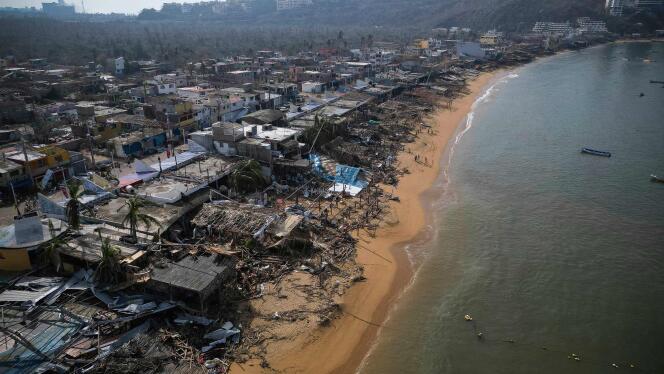


A week after Category 5 Hurricane Otis hit Acapulco, Mexico, on the night of October 24-25, the full extent of the damage is emerging. The human toll has risen to 46 people dead and 58 missing. The images of ransacked hotels that circulated shortly after the disaster did not show the most severe urban destruction. These buildings on the shores of the Pacific Ocean were hit by the strongest gusts of wind and had their interior architecture destroyed, but their concrete structures are still standing. However, in the outlying districts, where homes were built of sheet metal, wood or brick, many residents have no building left to live in.
A satellite map from the European Union's space program (Copernic), published on Sunday, October 29, showed the most devastated areas in red. If the image is superimposed on the map of Acapulco produced by the government's social services, the poorest areas can be seen to be the most affected Hurricane Otis.
No, no matan los huracanes, mata la pobreza. No es coincidencia que estos mapas se parezcan.
— Viri Ríos (@Viri_Rios) October 30, 2023
Rezago social (@coneval) // Daños Otis (@reforma) pic.twitter.com/MLCXUqaHkg
Poor urban planning in the coastal areas worsened the disaster. According to urban planner Federico Taboada, the tourist industry was given every opportunity to build on the beachfront with too few constraints. "By comparison, in Rio de Janeiro [Brazil], for example, there is an average distance of 210 meters between the sea and the first building, precisely to absorb any rise in sea level," he explained, "in Acapulco, it's just 13 meters."
According to initial estimates, 580,000 people have lost their homes, 7,000 hectares of buildings have been destroyed or damaged, and over 900 kilometers of roads and streets have been flooded or damaged. The Mexican Insurance Association has estimated the damage at $15 billion (€14.2 billion), making Hurricane Otis one of the 10 most expensive disasters in the country's history. However, in the end, insurance companies did little to help: only 7% of property (16,000 buildings and 20,000 cars) was insured. The state will have to bear the brunt of the disaster costs.
The immense challenge facing the Mexican authorities is to put a city of almost one million inhabitants back on its feet and fix urban planning shortcomings. "For once, we need to give priority to the most disadvantaged areas," Taboada said. Center-left President Andrés Manuel López Obrador, aka "AMLO," has not mentioned any such projects so far, although he authorized tax breaks to facilitate reconstruction on Monday.
The president must respond to criticism from his political opponents about the delay in alerting the population of the danger posed by the hurricane. He must also deal with the emergency, with residents lacking everything, including access to drinking water. Electricity has just been restored and the water distribution network is soon expected to be restored, which was damaged.
You have 30% of this article left to read. The rest is for subscribers only.
